Abstract
A Tn5-induced mutant of Bradyrhizobium japonicum, strain LORBF1, was isolated on the basis of the formation of fluorescent colonies, and stable derivatives were constructed in backgrounds of strains LO and I110. The stable mutant strains LOek4 and I110ek4 were strictly dependent upon the addition of exogenous hemin for growth in liquid culture and formed fluorescent colonies. The fluorescent compound was identified as protoporphyrin IX, the immediate precursor of protoheme. Cell extracts of strains LOek4 and I110ek4 were deficient in ferrochelatase activity, the enzyme which catalyzes the incorporation of ferrous iron into protoporphyrin IX to produce protoheme. Mutant strain I110ek4 could take up 55Fe from the growth medium, but, unlike the parent strain, no significant incorporation of radiolabel into heme was found. This observation shows that heme was not synthesized in mutant strain I110ek4 and that the heme found in those cells was derived from exogenous hemin in the growth medium. The putative protein encoded by the gene disrupted in strain LORBF1 and its derivatives was homologous to ferrochelatases from eukaryotic organisms. This homology, along with the described mutant phenotype, provides strong evidence that the disrupted gene is hemH, that which encodes ferrochelatase. Mutant strain I110ek4 incited nodules on soybean that did not fix nitrogen, contained few viable bacteria, and did not express leghemoglobin heme or apoprotein. The data show that B. japonicum ferrochelatase is essential for normal nodule development.
Full text
PDF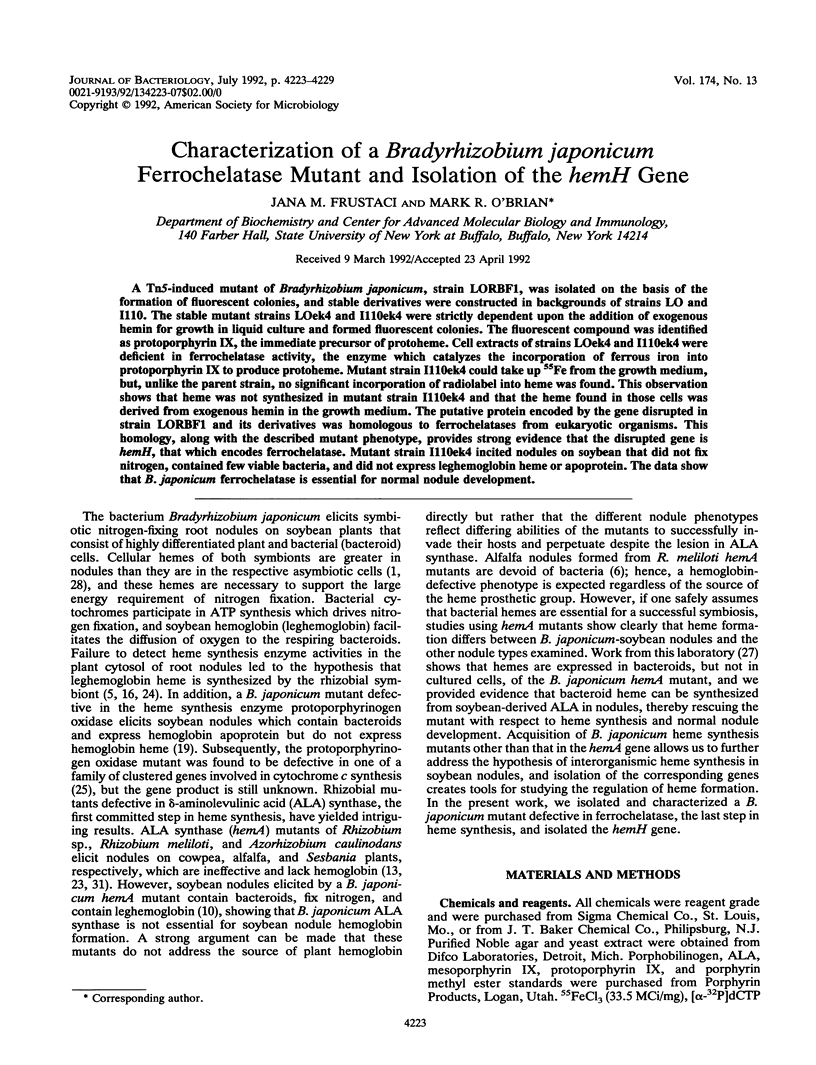
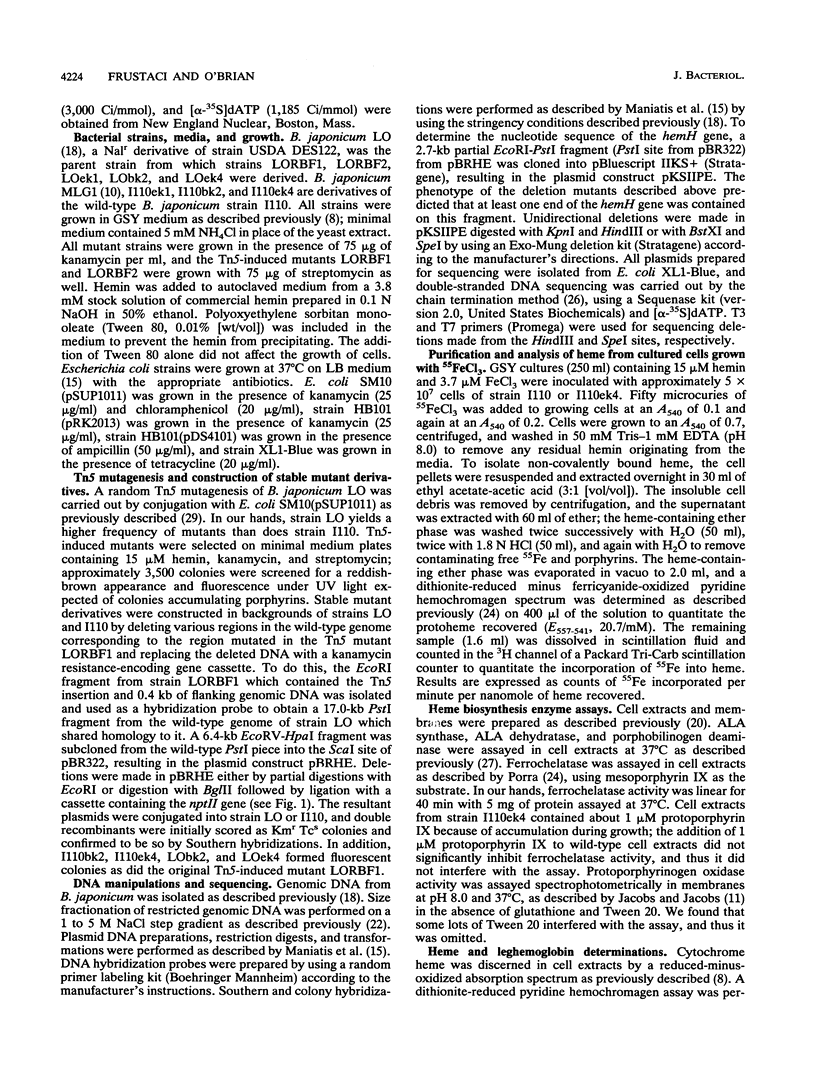
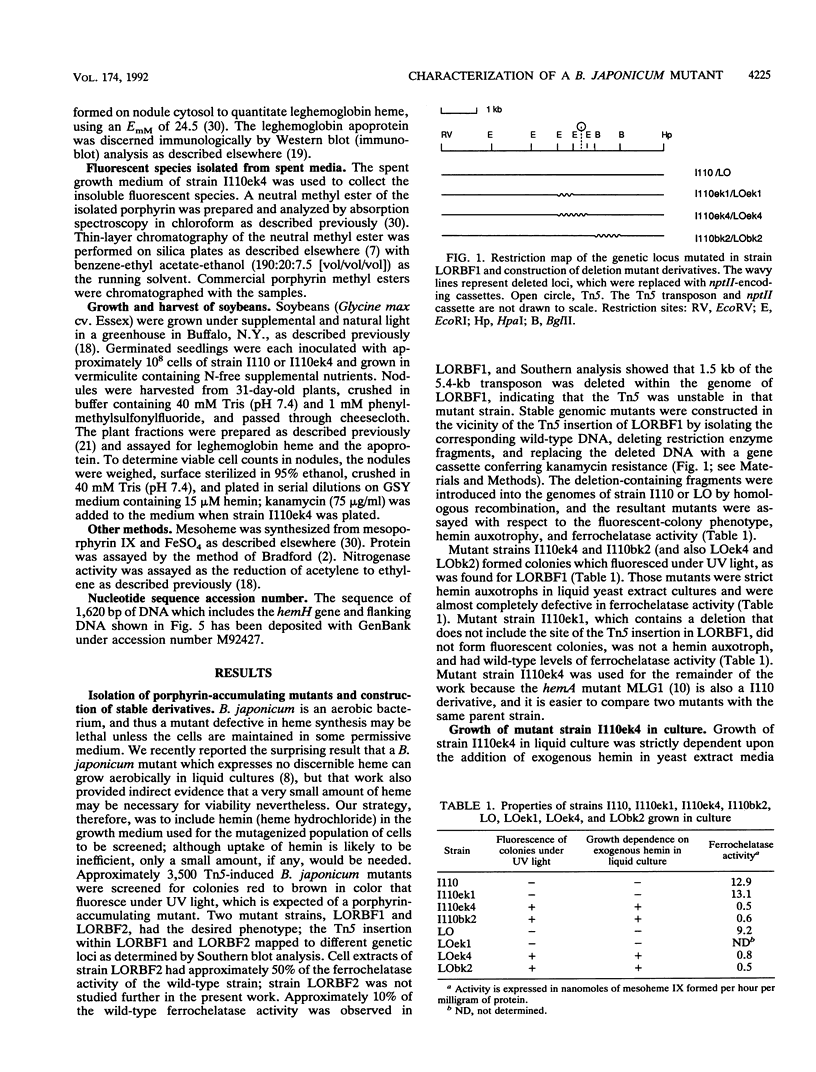
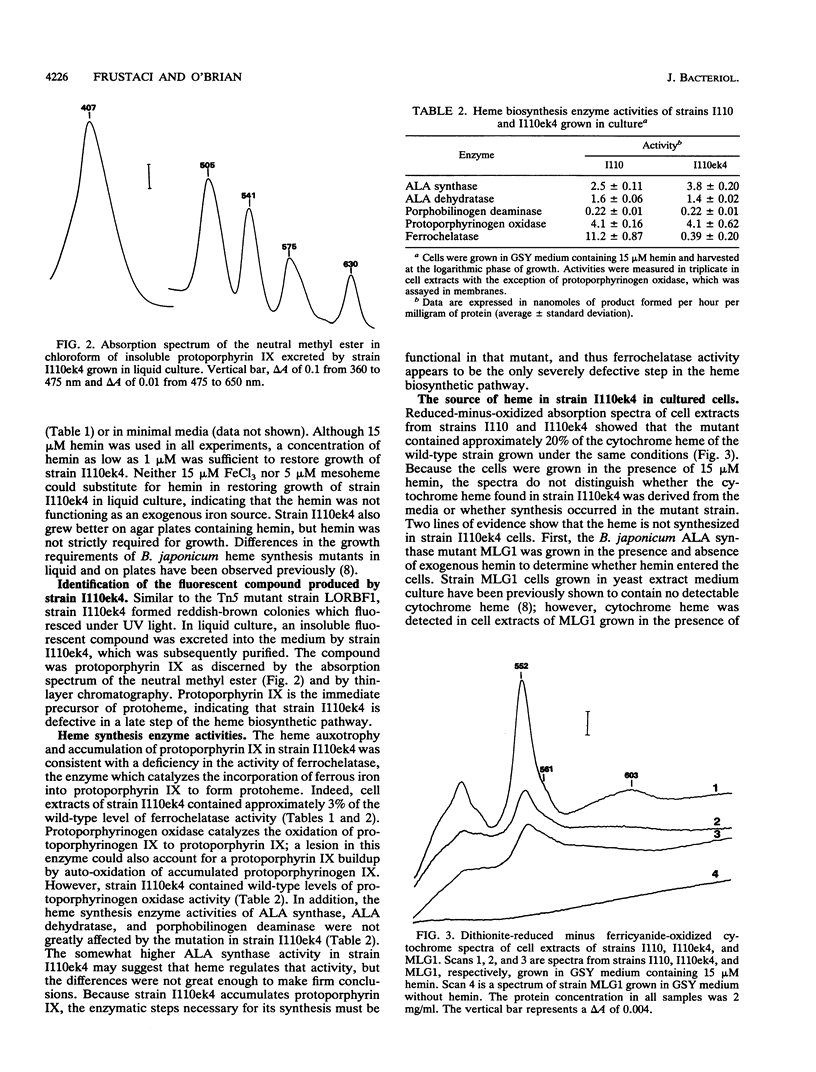
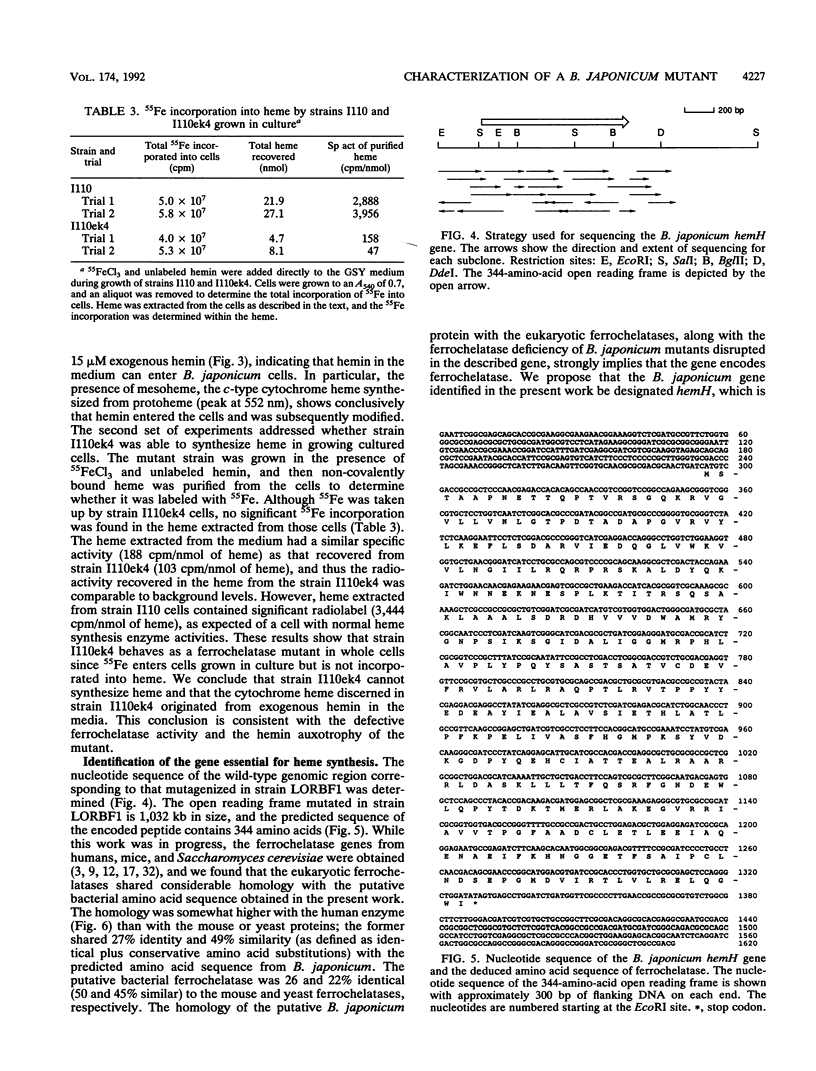
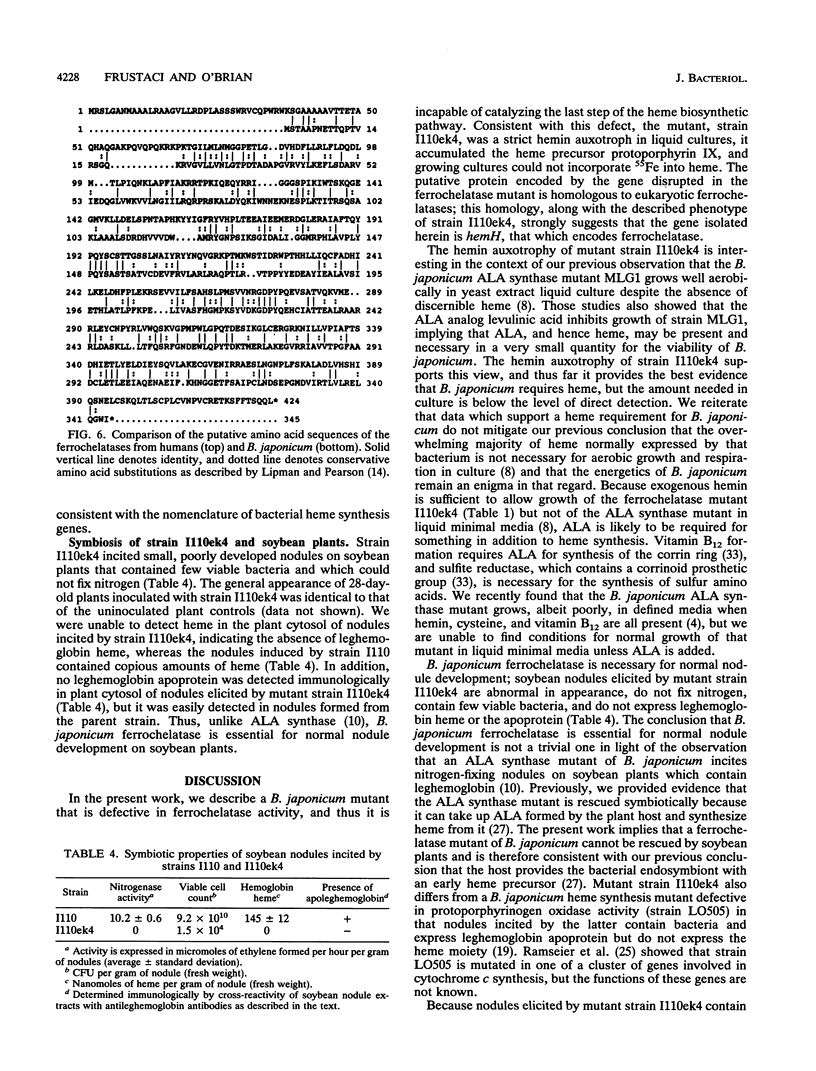
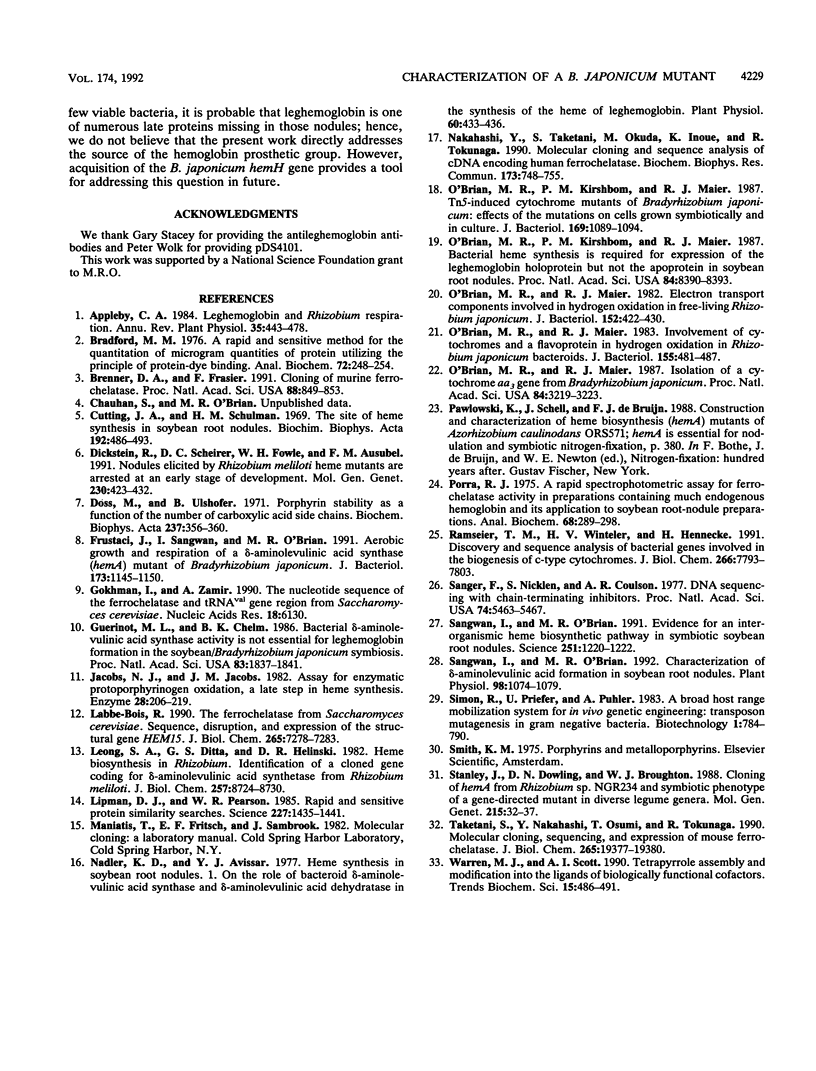
Selected References
These references are in PubMed. This may not be the complete list of references from this article.
- Bradford M. M. A rapid and sensitive method for the quantitation of microgram quantities of protein utilizing the principle of protein-dye binding. Anal Biochem. 1976 May 7;72:248–254. doi: 10.1016/0003-2697(76)90527-3. [DOI] [PubMed] [Google Scholar]
- Brenner D. A., Frasier F. Cloning of murine ferrochelatase. Proc Natl Acad Sci U S A. 1991 Feb 1;88(3):849–853. doi: 10.1073/pnas.88.3.849. [DOI] [PMC free article] [PubMed] [Google Scholar]
- Cutting J. A., Schulman H. M. The site of heme synthesis in soybean root nodules. Biochim Biophys Acta. 1969 Dec 30;192(3):486–493. doi: 10.1016/0304-4165(69)90398-5. [DOI] [PubMed] [Google Scholar]
- Dickstein R., Scheirer D. C., Fowle W. H., Ausubel F. M. Nodules elicited by Rhizobium meliloti heme mutants are arrested at an early stage of development. Mol Gen Genet. 1991 Dec;230(3):423–432. doi: 10.1007/BF00280299. [DOI] [PubMed] [Google Scholar]
- Doss M., Ulshöfer B. Porphyrin stability as a function of the number of carboxylic acid side chains. Biochim Biophys Acta. 1971 May 18;237(2):356–360. doi: 10.1016/0304-4165(71)90330-8. [DOI] [PubMed] [Google Scholar]
- Frustaci J. M., Sangwan I., O'Brian M. R. Aerobic growth and respiration of a delta-aminolevulinic acid synthase (hemA) mutant of Bradyrhizobium japonicum. J Bacteriol. 1991 Feb;173(3):1145–1150. doi: 10.1128/jb.173.3.1145-1150.1991. [DOI] [PMC free article] [PubMed] [Google Scholar]
- Gokhman I., Zamir A. The nucleotide sequence of the ferrochelatase and tRNA(val) gene region from Saccharomyces cerevisiae. Nucleic Acids Res. 1990 Oct 25;18(20):6130–6130. doi: 10.1093/nar/18.20.6130. [DOI] [PMC free article] [PubMed] [Google Scholar]
- Guerinot M. L., Chelm B. K. Bacterial delta-aminolevulinic acid synthase activity is not essential for leghemoglobin formation in the soybean/Bradyrhizobium japonicum symbiosis. Proc Natl Acad Sci U S A. 1986 Mar;83(6):1837–1841. doi: 10.1073/pnas.83.6.1837. [DOI] [PMC free article] [PubMed] [Google Scholar]
- Jacobs N. J., Jacobs J. M. Assay for enzymatic protoporphyrinogen oxidation, a late step in heme synthesis. Enzyme. 1982;28(2-3):206–219. doi: 10.1159/000459103. [DOI] [PubMed] [Google Scholar]
- Labbe-Bois R. The ferrochelatase from Saccharomyces cerevisiae. Sequence, disruption, and expression of its structural gene HEM15. J Biol Chem. 1990 May 5;265(13):7278–7283. [PubMed] [Google Scholar]
- Leong S. A., Ditta G. S., Helinski D. R. Heme biosynthesis in Rhizobium. Identification of a cloned gene coding for delta-aminolevulinic acid synthetase from Rhizobium meliloti. J Biol Chem. 1982 Aug 10;257(15):8724–8730. [PubMed] [Google Scholar]
- Lipman D. J., Pearson W. R. Rapid and sensitive protein similarity searches. Science. 1985 Mar 22;227(4693):1435–1441. doi: 10.1126/science.2983426. [DOI] [PubMed] [Google Scholar]
- Nadler K. D., Avissar Y. J. Heme Synthesis in Soybean Root Nodules: I. On the Role of Bacteroid delta-Aminolevulinic Acid Synthase and delta-Aminolevulinic Acid Dehydrase in the Synthesis of the Heme of Leghemoglobin. Plant Physiol. 1977 Sep;60(3):433–436. doi: 10.1104/pp.60.3.433. [DOI] [PMC free article] [PubMed] [Google Scholar]
- Nakahashi Y., Taketani S., Okuda M., Inoue K., Tokunaga R. Molecular cloning and sequence analysis of cDNA encoding human ferrochelatase. Biochem Biophys Res Commun. 1990 Dec 14;173(2):748–755. doi: 10.1016/s0006-291x(05)80099-3. [DOI] [PubMed] [Google Scholar]
- O'Brian M. R., Kirshbom P. M., Maier R. J. Bacterial heme synthesis is required for expression of the leghemoglobin holoprotein but not the apoprotein in soybean root nodules. Proc Natl Acad Sci U S A. 1987 Dec;84(23):8390–8393. doi: 10.1073/pnas.84.23.8390. [DOI] [PMC free article] [PubMed] [Google Scholar]
- O'Brian M. R., Kirshbom P. M., Maier R. J. Tn5-induced cytochrome mutants of Bradyrhizobium japonicum: effects of the mutations on cells grown symbiotically and in culture. J Bacteriol. 1987 Mar;169(3):1089–1094. doi: 10.1128/jb.169.3.1089-1094.1987. [DOI] [PMC free article] [PubMed] [Google Scholar]
- O'Brian M. R., Maier R. J. Electron transport components involved in hydrogen oxidation in free-living Rhizobium japonicum. J Bacteriol. 1982 Oct;152(1):422–430. doi: 10.1128/jb.152.1.422-430.1982. [DOI] [PMC free article] [PubMed] [Google Scholar]
- O'Brian M. R., Maier R. J. Involvement of cytochromes and a flavoprotein in hydrogen oxidation in Rhizobium japonicum bacteroids. J Bacteriol. 1983 Aug;155(2):481–487. doi: 10.1128/jb.155.2.481-487.1983. [DOI] [PMC free article] [PubMed] [Google Scholar]
- O'brian M. R., Maier R. J. Isolation of a cytochrome aa(3) gene from Bradyrhizobium japonicum. Proc Natl Acad Sci U S A. 1987 May;84(10):3219–3223. doi: 10.1073/pnas.84.10.3219. [DOI] [PMC free article] [PubMed] [Google Scholar]
- Porra R. J. A rapid spectrophotometric assay for ferrochelatase activity in preparations containing much endogenous hemoglobin and its application to soybean root-nodule preparations. Anal Biochem. 1975 Sep;68(1):289–298. doi: 10.1016/0003-2697(75)90707-1. [DOI] [PubMed] [Google Scholar]
- Ramseier T. M., Winteler H. V., Hennecke H. Discovery and sequence analysis of bacterial genes involved in the biogenesis of c-type cytochromes. J Biol Chem. 1991 Apr 25;266(12):7793–7803. [PubMed] [Google Scholar]
- Sanger F., Nicklen S., Coulson A. R. DNA sequencing with chain-terminating inhibitors. Proc Natl Acad Sci U S A. 1977 Dec;74(12):5463–5467. doi: 10.1073/pnas.74.12.5463. [DOI] [PMC free article] [PubMed] [Google Scholar]
- Sangwan I., O'brian M. R. Characterization of delta-Aminolevulinic Acid Formation in Soybean Root Nodules. Plant Physiol. 1992 Mar;98(3):1074–1079. doi: 10.1104/pp.98.3.1074. [DOI] [PMC free article] [PubMed] [Google Scholar]
- Sangwan I., O'brian M. R. Evidence for an inter-organismic heme biosynthetic pathway in symbiotic soybean root nodules. Science. 1991 Mar 8;251(4998):1220–1222. doi: 10.1126/science.251.4998.1220. [DOI] [PubMed] [Google Scholar]
- Taketani S., Nakahashi Y., Osumi T., Tokunaga R. Molecular cloning, sequencing, and expression of mouse ferrochelatase. J Biol Chem. 1990 Nov 15;265(32):19377–19380. [PubMed] [Google Scholar]
- Warren M. J., Scott A. I. Tetrapyrrole assembly and modification into the ligands of biologically functional cofactors. Trends Biochem Sci. 1990 Dec;15(12):486–491. doi: 10.1016/0968-0004(90)90304-t. [DOI] [PubMed] [Google Scholar]


